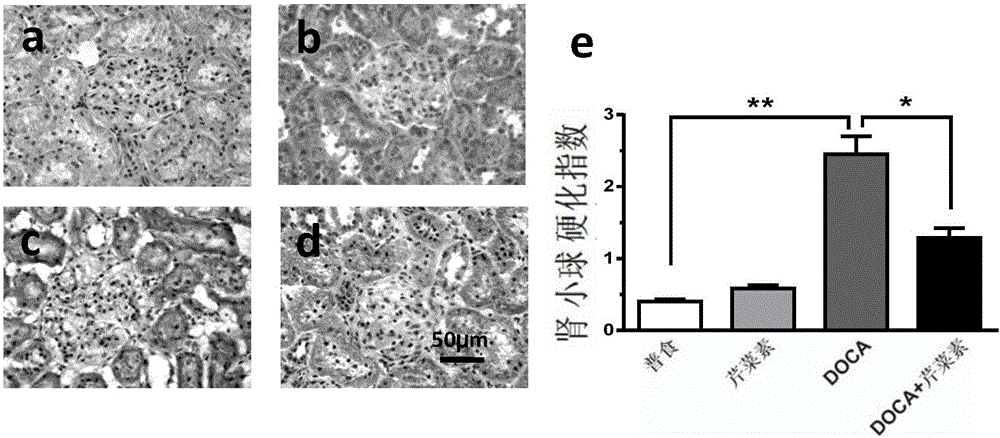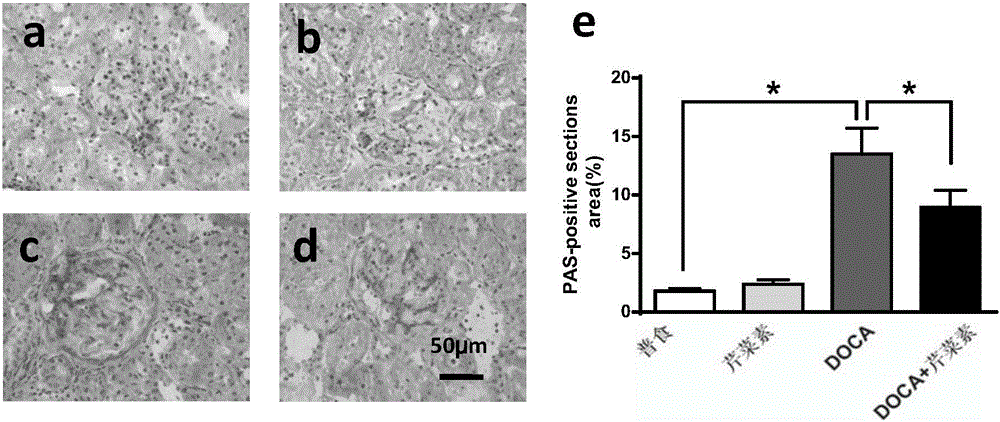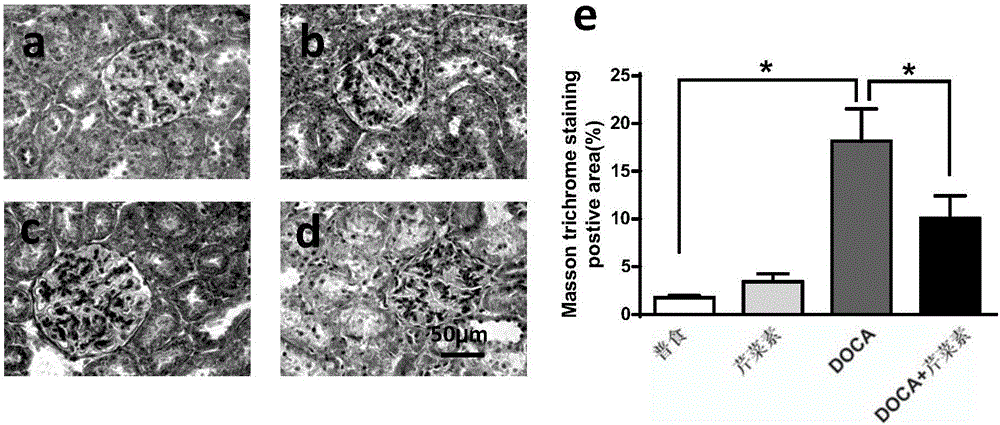Application of apigenin in preparation of drugs for preventing and treating renal fibrosis
A technology of kidney fibrosis and apigenin, applied in the field of medicine, can solve the problems of prolonging the life of patients and unsolved fundamental problems, and achieves the effect of treating kidney fibrosis, improving kidney fibrosis, and having obvious effect.
- Summary
- Abstract
- Description
- Claims
- Application Information
AI Technical Summary
Problems solved by technology
Method used
Image
Examples
Embodiment 1D
[0051] Example 1 DOCA-salt-induced renal fibrosis animal model
[0052] 1. DOCA-salt-induced renal fibrosis animal model:
[0053] Twenty-four healthy 2-month-old male SD rats (provided by the Animal Experiment Center of Daping Hospital, Third Military Medical University), weighing 250-300 g, were housed in separate cages and allowed to eat and drink freely. Natural day and night lighting, room temperature 18°C-26°C, feeding in the morning and evening every day, changing water every other day. Humidity around 50%. They were adaptively fed for 1 week before the operation, and then the left nephrectomy was performed. Rats were weighed and anesthetized by intraperitoneal injection of 10% urethane solution (1m1 / kg), then the back operation area was sheared, fixed on the operation board in the prone position, and after strict disinfection, a test was made on the left side of the spine and the lower edge of the twelfth rib. An incision about 2 cm in length was made to separate th...
Embodiment 2
[0058] Embodiment 2 animal experiments
[0059] 1. Determination of body weight: common weighing method.
[0060] 2. Determination of urinary albumin and creatinine, the results are as follows: Image 6 shown.
[0061] 2.1 Collection of 24-hour urine samples
[0062] After the dietary intervention, the rats were placed in metabolic cages in the morning, fed in separate cages, 1 rat per cage, fasted, and free to drink water. Natural lighting day and night, room temperature 18°C-26°C, humidity around 50%. Feed was added by special personnel, and the weight of the feed was weighed regularly with a balance every day, and the daily food intake of each rat was calculated. Collect 24-hour urine volume, centrifuge at 4000r / min at room temperature for 10min, and store in -70°C refrigerator for later use.
[0063] 2.2 Reagent preparation, usage and storage
[0064] Alb. Standards: Add 0.5ml of buffer solution to dissolve each standard, shake well after 15 minutes of dissolution. ...
Embodiment 3
[0116] Embodiment 3 molecular experiment
[0117] 1. Western blot, the results are as follows Figure 10 , Figure 11 and Figure 12 shown.
[0118] 1.1 Tissue and cell total protein extraction method
[0119] 1.1.1 Take 100mg of tissue and add appropriate amount of pre-cooled RIPA lysate (1ml protein homogenization buffer plus PMSF50ug, Leuptin 5ug), homogenize with a homogenizer, collect the homogenate in a 1.5ml centrifuge tube; if it is a cell sample, Add an appropriate amount of lysate directly to the culture flask or six-well plate, and collect the cells with a cell scraper.
[0120] 1.1.2-20°C for 20 minutes to precipitate protein.
[0121] 1.1.3 Centrifuge at 12,000 rpm at 4°C for 20 minutes, collect the supernatant, namely histoprotein, for protein quantification and immunoblotting experiments, or freeze at -70°C for later use.
[0122] 1.1.4 Protein quantification method (Bradford method)
[0123] 1.1.5 Preparation of protein standard solution: Prepare 1 mg / ml...
PUM
 Login to View More
Login to View More Abstract
Description
Claims
Application Information
 Login to View More
Login to View More - R&D Engineer
- R&D Manager
- IP Professional
- Industry Leading Data Capabilities
- Powerful AI technology
- Patent DNA Extraction
Browse by: Latest US Patents, China's latest patents, Technical Efficacy Thesaurus, Application Domain, Technology Topic, Popular Technical Reports.
© 2024 PatSnap. All rights reserved.Legal|Privacy policy|Modern Slavery Act Transparency Statement|Sitemap|About US| Contact US: help@patsnap.com










